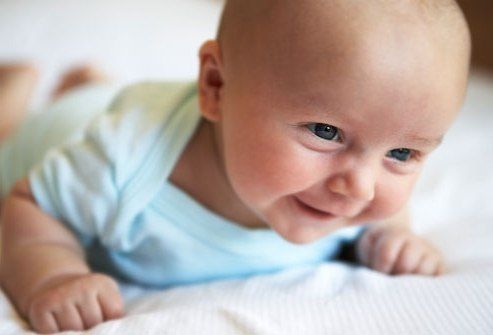Medical expert of the article
New publications
What should a baby be able to do at 3 months?
Last reviewed: 04.07.2025

All iLive content is medically reviewed or fact checked to ensure as much factual accuracy as possible.
We have strict sourcing guidelines and only link to reputable media sites, academic research institutions and, whenever possible, medically peer reviewed studies. Note that the numbers in parentheses ([1], [2], etc.) are clickable links to these studies.
If you feel that any of our content is inaccurate, out-of-date, or otherwise questionable, please select it and press Ctrl + Enter.

At three months, a child can already do a lot. He has the most joyful gift for mom and dad - a smile. A child can smile a lot and happily, and even laugh. What else can your baby do at 3 months?
Baby development at 3 months
Crying is no longer the only way a child communicates with parents and others. He can already coo, smile widely and even laugh. This is how a child shows his attitude to the world and his happiness from being alive. Did you know that neonatologists who work with babies observe more than 70 types of smiles in three-month-old babies? If a mother loves her child and is attentive to his needs, she will also be able to distinguish these types of smiles.
Read also: |
If the child is unhappy, he can already cry more sharply. Scream, express his discontent. A child at 3 months can already hold his head for quite a long time, lifting it. He can already lift his shoulders, chest, and lying on his stomach.
Three-month-old babies (though not all) learn to roll over. The side of the playpen or crib helps them with this. They can kick toys with their feet and then laugh out loud if the toy jingles. Three-month-old babies really like to listen to their mom or dad read them poems or sing songs.
Baby at 3 months: motor skills
At this age, a child has well-developed innate reflexes - for example, the startle reflex. You probably notice that your child's neck strength is also increasing. When you hold your child upright, he already holds his head well. Three-month-old children can lift their upper body, using their arms, while holding their head.
If you've been watching your baby, you should notice some early signs of hand-eye coordination. Your 3-month-old baby's fists may be opening and closing, and your baby may be able to quickly grab a toy or rattle and pull it into his mouth.
Parents should know that at three months, a child can gain 800 g in weight per month. And his height also increases very quickly - up to 2.5 cm per month. If you have a boy, then the volume of his head at 3 months reaches 41 cm, and the volume of the chest is on average 41 cm. In girls, the volume of the head and chest is slightly smaller - about 40 cm. The central nervous system of a three-month-old child continues to form.
His bones continue to grow and harden. Therefore, the child still needs to be handled very carefully so as not to break them or displace fragile joints. Therefore, the baby should not be swaddled tightly. It is also impossible to sit him up early - especially girls, whose pelvic bones may shift from the anatomically correct place.
 [ 1 ]
[ 1 ]
Feeding a three month old baby
Don't listen to advice that at three months of age you should start introducing solid food to your baby. This is not true - at least a few more months should pass before your baby reaches six months.
Of course, it is very difficult to determine how much milk a baby who is breastfed sucks. But it is worth knowing that the norm for a three-month-old baby during the day is up to 850 grams of milk. At one time, this will be a portion of about 120-140 grams. You can determine the milk norm for a child yourself: just divide the baby's weight by 6 (the number of feedings). You will get the amount of milk in grams that is optimal for your three-month-old child.
Between feedings, you need to wait about 3-3.5 hours. At the same time, you need to include vitamin D in the child's diet - this will allow the child's bones and skin, as well as his hair and nails, to develop better.
A three-month-old baby – how much and when to sleep?
Your baby's nervous system at 3 months becomes stronger, the stomach stretches and can accommodate more mother's milk. But the baby can now sleep less than in the first months after birth.
If your baby wakes up in the middle of the night, wait about 30 seconds before going to him. Sometimes 3-month-olds may cry for a few seconds and then fall back asleep – without any parental intervention. Rushing to your baby at the first sound may wake him instead of letting him fall asleep on his own.

If the middle-of-the-night screaming doesn't stop, you should go into your baby's room to help him. Feedings and diaper changes should be done in the dark if possible, and then put your baby back in the crib. Eventually, your baby will understand that nighttime is only for sleeping.
Your baby's daytime sleep schedule should also be calm - without loud noises in the room. Most 3-month-old babies sleep between one and a half and two hours each day. The total number of hours of sleep for a three-month-old baby is no longer 22, as in the first month after birth, but up to 17 hours.
The third month of a child's life: vision and hearing
Your baby's hearing and vision are gradually improving at three months of age. Babies this age turn their heads and smile at the sound of their parents' voices, and they also enjoy listening to all kinds of music.
Your baby will still pay special attention to brightly colored toys. This is because sharp contrasts are easier for him to see. Faces are still very fascinating to him. Look at your baby, and he will look into your eyes, too. Your baby will also stare at his reflection in the mirror.
The third month of baby development: connection with the surrounding world
At three months, your baby is becoming increasingly unique. This is the stage that child psychiatrist Margaret Mahler calls "hatching," when babies come out of their shells and begin to respond to the world around them. Part of this hatching process involves interacting with people and smiling with pleasure, better known in the medical community as social smiles.
By the third month of life, crying is no longer your baby's primary method of communication. Three-month-old babies may no longer cry for more than an hour in total during the day. If the crying exceeds this "norm" or seems too long for you, consult your pediatrician, as it may be a medical issue.
Instead of crying, your baby will begin to communicate in other ways, such as cooing and making vowel sounds (''O'' and ''ah'', for example). Engage your baby in conversation by responding to these sounds when you're together. Say, ''I'm going to change your diaper'' or ''It's time for dinner!'' Your baby will listen to the sound of your voice with delight and watch your facial expressions when you talk. Eventually, he'll begin to form his own sounds and his own gestures. Talking is a great way to bond with your three-month-old.
Walking with a 3 month old baby
Walking with a three-month-old baby is a very good idea. It toughens him up. Fresh air is good for the lungs, skin, and cardiovascular system. It is advisable to walk at least 6 hours a day, even if the weather outside is not very warm. But if the temperature is below minus 10 degrees, you should not walk - the baby can catch a cold. But you can roll the stroller with the baby out onto a glazed balcony or loggia.
Sun rays are very useful for a child, because when exposed to them, the skin actively begins to produce vitamin D. And this vitamin is a preventative measure against bone diseases and such a dangerous disease as rickets. Sun rays are a very good protection against anemia. Walking in the fresh air protects the child's immune system very well. But there is a nuance: the child should not be kept in a draft or under direct sunlight. This can lead to a cold in the first case or to burns in the second.
Third Month of Baby Development: Missed Milestones
Every baby is unique and different from other babies. Don't be alarmed if your 3-month-old baby is missing any milestones, especially if he was born prematurely. However, don't worry about your pediatrician if your baby hasn't done the following things by the time he's 3 months old:
- Does not respond to noise.
- Does not follow people or objects with his eyes.
- Doesn't smile.
- Doesn't laugh.
How to play with a three month old baby?
- Show your child bright toys at a distance of 25-30 cm from the eyes. Move the toy right-left-up-down. Let the child follow the toy with his eyes. This will train his focus and eye muscles.
- Buy toys that make sounds: ring, make noise, squeak. Move these toys left and right from the baby, and let them make sounds. The baby will learn to catch sounds. You need to ask him: "Where is it ringing?" Of course, a 3-month-old baby will not be able to answer you, but he will catch the general information and the tone in which an adult speaks.
- Give the child toys so that he can grasp them with his fingers. This way the child will train his hand, fingers, and improve his grasping reflex. It is better if the toys are of different shapes, but such that the child's hand can grasp them. This way he will get used to taking something with his hands.
- Train your baby's legs. At three months, babies still have hypertonicity of the limbs. If you put your baby on a hard surface and take him under the arms, supporting him, he will move his legs as if walking. Move your baby from his back to his tummy and vice versa, and then he will train the muscles of his back and neck.
A three-month-old baby requires even more attention and care from parents. And they, in turn, need to know what a three-month-old baby should be able to do to help him develop.
 [ 2 ]
[ 2 ]

